Features
Buddhist Theory of Kamma
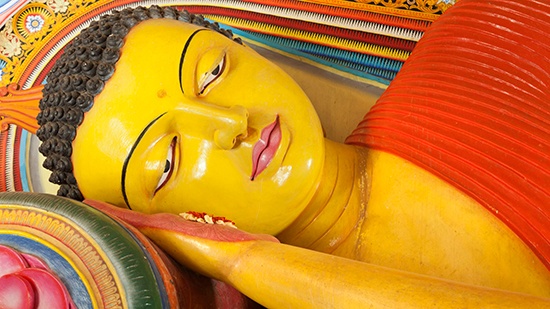
by Venerable Narada Maha Thera
Kamma is the law of moral causation. The theory of kamma is a fundamental doctrine in Buddhism. This belief was prevalent in India before the advent of the Buddha. Nevertheless, it was the Buddha who explained and formulated this doctrine in the complete form in which we have it today.
What is the cause of inequality that exists among mankind?
Why should one person be brought up in the lap of luxury, endowed with fine mental, moral and physical qualities, and another in absolute poverty, steeped in misery?
Why should one person be a mental prodigy and another an idiot’?
Why should one person be born with saintly characteristics and another with criminal tendencies?
Why should some be linguistic, artistic, mathematically inclined, or musical from the very cradle.
Why should others be congenitally blind, deaf, or deformed? Why should some be blessed and others cursed from their births?
Either this inequality of mankind has a cause or it is purely accidental. No sensible person would think of attributing this unevenness, this inequality, and this diversity to blind chance or pure accident.
In this world nothing happens to a person that he does not for some reason or other deserve. Usually, men of ordinary intellect cannot comprehend the actual reason or reasons. The definite invisible cause or causes of the visible effect is not necessarily confined to the present life, they may be traced to a proximate or remote past birth.
According to Buddhism, this inequality is due not only to heredity, environment, “nature and nurture”, but also to kamma. In other words, it is the result of our own past actions and our own present doings. We ourselves are responsible for our own happiness and misery. We create our own Heaven. We create our own Hell. We are the architects of our own fate.
Perplexed by the seemingly inexplicable, apparent disparity that existed among humanity, a young truth-seeker approached the Buddha and questioned him regarding this intricate problem of inequality:
“What is the cause, what is the reason, 0 Lord,” questioned lie, “that we find amongst mankind the short-lived and long-lived, the healthy and the diseased, the ugly and beautiful, those lacking influence and the powerful, the poor and the rich, the low-born and the high-born, and the ignorant and the wise?”
The Buddha’s reply was:
“All living beings have actions (Kamma) as their own, their inheritance, their congenital cause, their kinsman, their refuge. It is kamma that differentiates beings into low and high states.”
The Buddha then explained the cause of such differences in accordance with the law of cause and effect.
Certainly we are born with hereditary characteristics. At the same time we possess certain innate abilities that science cannot adequately account for. To our parents we are indebted for the gross sperm and ovum that form the nucleus of this so-called being. They remain dormant within each parent until this potential germinal compound is vitalised by the karmic energy needed for the production of the foetus. kamma is therefore the indispensable conceptive cause of this being.
The accumulated karmic tendencies, inherited in the course of previous lives, at times play a far greater role than the hereditary parental cells and genes in the formation of both physical and mental characteristics.
The Buddha for instance, inherited, like every other person, the reproductive cells and genes from his parents. But physically, morally and intellectually there was none comparable to him in his long line of Royal ancestors. In the Buddha’s own words, he belonged not to the Royal lineage, but to that of the Aryan Buddhas. He was certainly a superman, an extraordinary creation of his own kamma.
According to the Lakkhana Sutta of Digha Nikaya, the Buddha inherited exceptional features, such as the 32 major marks, as the result of his past meritorious deeds. The ethical reason for acquiring each physical feature is clearly explained in the Sutta.
It is obvious from this unique case that karmic tendencies could not only influence our physical organism, but also nullify the potentiality of the parental cells and genes – hence the significance of the Buddha’s enigmatic statement, – “We are the heirs of our own actions.”
Dealing with this problem of variation, the Atthasalini, being a commentary on the Abhidharma, states:
“Depending on this difference in Karma appears the differences in the birth of beings, high and low, base and exalted, happy and miserable. Depending on the difference in karma appears the difference in the individual features of beings as beautiful and ugly, high-born or low born, well-built or deformed. Depending on the difference in karma appears the difference in worldly conditions of beings, such as gain and loss, and disgrace, blame and praise, happiness and misery. “
Thus, from a Buddhist point of view, our present mental, moral intellectual and temperamental differences are, for the most part, due to our own actions and tendencies, both past and present.
Although Buddhism attributes this variation to kamma as being the chief cause among a variety, it does not, however, assert that everything is due to kamma. The law of kamma, important as it is, is only one of the twenty-four conditions described in Buddhist Philosophy.
Refuting the erroneous view that “whatsoever fortune or misfortune experienced is all due to some previous action”, the Buddha said:
“So, then, according to this view owing to previous actions men will become murderers, thieves, unchaste, liars, slanderers, covetous, malicious and perverts. Thus, for those who fall back on the former deeds as the essential reason, there is neither the desire to do, nor effort to do, nor necessity to do this deed, or abstain from this deed. “
It was this important text, which states the belief that all physical circumstances and mental attitudes spring solely from past kamma that Buddha contradicted. If the present life is totally conditioned or wholly controlled by our past actions, then certainly kamma is tantamount to fatalism or determinism or predestination. If this were true, free will would be an absurdity. Life would be purely mechanistic, not much different from a machine. Being created by an Almighty God who controls our destinies and predetermines our future, or being produced by an irresistible kamma that completely determines our fate and controls our life’s course, independent of any free action on our part, is essentially the same. The only difference lies in the two words God and kamma. One could easily be substituted for the other, because the j ultimate operation of both forces would be identical.
Such a fatalistic doctrine is not the Buddhist law of kamma, Five Processes for Kamma Niyama.
According to Buddhism, there are five orders or processes (niyama) which operate in the physical and mental realms.
They are:
1. Utu Niyama –
physical inorganic order, e.g. seasonal phenomena of winds and rains. The unerring order of seasons, characteristic seasonal changes and events, causes of winds and rains, nature of heat, etc., all belong to this group.
2. Beeja Niyama –
order of germs and seeds (physical organic order), e.g. rice produced from rice-seed, sugary taste from sugar-cane or honey, peculiar characteristics of certain fruits, etc. The scientific theory of cells and genes and the physical similarity of twins may be ascribed to this order.
3. Kamma Niyama –
order of act and result, e.g., desirable and undesirable acts produce corresponding good and bad results. As surely as water seeks its own level so does kamma, given opportunity, produce its inevitable result, not in the form of a reward or punishment but as an innate sequence. This sequence of deed and effect is as natural and necessary as the way of the sun and the moon.
4. Dhamma Niyama –
order of the norm, e.g. the natural phenomena occurring at the advent of a Bodhisattva in his last birth. Gravitation and other similar laws of nature. The natural reason for being good and so forth, many be included in this group.
5. Citta Niyama –
order or mind or psychic law, e.g., processes of consciousness, arising and perishing of consciousness, constituents of consciousness, power of mind, etc. including telepathy, telaesthesia, retro-cognition, premonition, clairvoyance, clairaudience, thought-reading and such other psychic phenomena which are inexplicable to modern science.
Every mental or physical phenomenon could be explained by these all-embracing five orders or processes which are laws in themselves. kamma as such is only one of these five orders. Like all other natural laws they demand no lawgiver.
Of these five, the physical inorganic order and the order of the norm are more or less mechanistic, though they can be controlled to some extent by human ingenuity and the power of mind. For example, fire normally burns, and extreme cold freezes, but man has walked scatheless over fire and meditated naked on Himalayan snows; horticulturists have worked marvels with flowers and fruits; Yogis have performed levitation. Psychic law is equally mechanistic, but Buddhist training aims at control of mind, which ispossible by right understanding and skilful volition. The kamma law operates quite automatically and, when the kamma is powerful, man cannot interfere with its inexorable result though he may desire to do so; but here also right understanding and skilful volition can accomplish much and mould the future. Good kamma, persisted in, can thwart the reaping of bad kamma, or as some Western scholars prefer to say ‘action influence’, is certainly an intricate law whose working is fully comprehended only by a Buddha. The Buddhist aims at the final destruction of all kamma.
WHAT IS KAMMA?
The Pali term kamma literally means action or doing. Any kind of intentional action whether mental, verbal, or physical, is regarded as kamma. It covers all that is included in the phrase “thought, word and deed”. Generally speaking, all good and bad action constitutes kamma. In its ultimate sense kamma means all moral and immoral volition. Involuntary, unintentional or unconscious actions, though technically deeds, do not constitute kamma, because volition, the most important factor in determining kamma, is absent.
The Buddha says :
“I declare, 0 Bhikkhus, that volition is kamma, having willed one acts by body, speech, and thought. ” (Anguttara Nikaya)
Every volitional action of individuals, save those of the Buddhas and Arahants, is called kamma. The exception made in their case is because they are delivered from both good and evil; they have eradicated ignorance and craving, the roots of kamma.
“Destroyed are their germinal seeds (Khina beeja); selfish desires no longer grow,” states the Ratans Sutta of the Sutta nipata.
This does not mean that the Buddha and Arahantas are passive. They are tirelessly active in working for the real well being and happiness of all. Their deeds ordinarily accepted as good or moral, lack creative power as regards themselves, Understanding things as they truly are, they have finally shattered their cosmic fetters – the chain of cause and effect.
Kamma does not necessarily mean past actions. It embraces both past and present deeds. Hence in one sense, we are the result of what we were; we will be the result of what we are.
In another sense, it should be added, we are not totally the result of what we were; we will not absolutely be the result of what we arc. The present is no doubt the offspring of the past and is the present of the future, but the present is not always a true index of either the past or the future; so complex is the working of kamma.
It is this doctrine of kamma that the mother teaches her child when she says “Be good and you will be happy and we will love you; but if you are bad, you will be unhappy and we will not love you.” In short, kamma is the law of cause and effect in the ethical realm.
KAM MA AND VIPAKA
Kamma is action, and Vipaka, fruit or result, is its reaction.
Just as every object is accompanied by a shadow, even so every volitional activity is inevitably accompanied by its due effect.
kamma is like potential seed: Vipaka could be likened to the fruit arising from the tree – the effect or result. Anisamsa and Adinaya are the leaves, flowers and so forth that correspond to external differences such as health, sickness and poverty-these are inevitable consequences, which happen at the same time. Strictly speaking, both kamma and Vipaka pertain to the mind.
As kamma may be good or bad, so may Vipaka, – the fruit – is good or bad. As kamma is mental so Vipaka is mental (of the mind). It is experienced as happiness, bliss, unhappiness or misery, according to the nature of the kamma seed. Anisainsa are the concomitant advantages material things such as prosperity, health and longevity. When Vipaka’s concomitant material things are disadvantageous, they arc known as Adairaja, full of wretchedness, and appear as poverty, ugliness, disease, short life-span and so forth.
As we sow, we reap somewhere and sometime, in this life or in a future birth. What we reap today is what we have sown either in the present or in the past.
The Samyutta Nikaya states :
“According to the seed that’s sown, So is the fruit you reap there from, Doer of good will gather good,
Doer of evil, evil reaps,
Down is the seed and thou shalt taste The fruit there of”
Kamma is a law in itself, which operates in its own field without the intervention of any external, independent ruling agency.
Happiness and misery, which are the common lot of humanity, are the inevitable effects of causes. From a Buddhist point of view, they are not rewards and punishments, assigned by a supernatural, omniscient ruling power to a soul that has done good or evil. Theists, who attempt to explain everything in this and temporal life and in the eternal future life, ignoring a past, believe in a ‘postmortem’ justice, and may regard present happiness and misery as blessings and curses conferred on His creation by an omniscient and omnipotent Divine Ruler who sits in heaven above controlling the destinies of the human race. Buddhism, which emphatically denies such an Almighty, All merciful God-Creator and an arbitrarily created immortal soul, believes in natural law and justice which cannot be suspended by either an Almighty God or an All-compassionate Buddha. According to this natural law, acts bear their own rewards and punishments to the individual doer whether human justice finds out or not.
There are some who criticise thus: “So, you Buddhists, too, administer capitalistic opium to the people, saying: “You are born poor in this life on account of your past evil kamma. He is born rich on account of his good kamma. So, be satisfied with your humble lot; but do good to be rich in your next life. You are being oppressed now because of your past evil kamma. There is your destiny. Be humble and bear your sufferings patiently. Do good now. You can be certain of a better and happier life after death.”
The Buddhist doctrine of kamma does not expound such ridiculous fatalistic views. Nor does it vindicate a postmortem justice. The All-Merciful Buddha, who had no ulterior selfish motives, did not teach this law of kamma to protect the rich and comfort the poor by promising illusory happiness in an after-life.
While we are born to a state created by ourselves, yet by our own self-directed efforts there is every possibility for us to create new, favourable environments even here and now. Not only individually, but also, collectively, we are at liberty to create fresh kamma that leads either towards our progress or downfall in this very life.
According to the Buddhist doctrine of kamma, one is not always compelled by an ‘iron necessity’, for Kamma is neither fate, nor predestination imposed upon us by some mysterious unknown power to which we must helplessly submit ourselves. It is one’s own doing reacting on oneself, and so one has the possibility to divert the course of one’s kamma to some extent. How far one diverts it depends on oneself.
Is one bound to reap all that one has sown in just proportion?
The Buddha provides an answer:
“if anyone says that a man or woman must reap in this life according to his present deeds, in that case there is no religious life, nor is an opportunity, afforded for the entire extinction of sorrow But if anyone says that what a man or woman reaps in this and future lives accords with his or her deeds present and past, in that case there is a religious life, and an opportunity is afforded for the entire extinction of ‘a sorrow” (Anguttara Nikaya)
Although it is stated in the Dhammapada that “not in the sky, nor in mid-ocean, or entering a mountain cave is found that place on earth where one may escape from (the consequences of) an evil deed”, yet one is not bound to pay all the past arrears of one’s kamma. If such were the case emancipation would be impossibility. Eternal recurrence would be the unfortunate result.
Features
Putin in Modi’s India

That was no ordinary greeting; on the frosty evening of last Thursday, Indian Prime Minister Modi embraced Russian President Vladimir Putin in a bear hug at Delhi airport and, within moments, presented him with a copy of the Bhagavad Gita in Russian. The choice of gift was laden with symbolism—echoes of Robert Oppenheimer, who drew profound philosophical reckoning from the same text, declaring, “Now I am become Death, the destroyer of worlds,” after witnessing the first atomic explosion. Was Modi signaling the weight of nuclear-age responsibility to Putin, or was this a deliberate affirmation of India’s comfort in maintaining ties with a pariah state under global sanctions?
The streets of Delhi, festooned with Russian and Indian flags and dominated by colossal billboards of Modi and Putin, suggested more than ceremonial protocol—it was pageantry of influence, an audacious statement of India’s strategic independence. In that gesture, New Delhi appeared to assert that moral judgment from the West would no longer dictate its choices, and that the Indo-Russian relationship, forged during the Cold War and hardened by decades of defence dependence, remains a pivot capable of unsettling the established order in South Asia and beyond.
Putin’s first visit to India in four years, coinciding with talks in Washington over a possible Ukraine peace framework, came at a time when New Delhi is walking an increasingly delicate tightrope between Moscow and Washington. The optics of the visit—from ceremonial receptions at Rashtrapati Bhavan to summit talks at Hyderabad House—reflected not merely diplomacy but an overt projection of influence. Modi’s presentation of the Bhagavad Gita in Russian was emblematic: a centuries-old text of dharma and duty, layered with the moral weight of choice, now inserted into the theatre of high-stakes realpolitik.
Putin himself, in an interview with India Today, described India as a “major global player, not a British colony,” praising Modi as a “reliable person” who does not succumb to pressure. These words, spoken against the backdrop of US sanctions, EU manoeuvres to leverage frozen Russian assets for Ukraine, and growing Chinese assertiveness, highlight India’s determination to claim agency in a multipolar world where Washington and Brussels no longer set the rules unilaterally.
Historically, the Indo-Russian relationship has oscillated between strategic necessity and opportunism. Declassified CIA documents from the 1980s reveal the delicate dance India played with the USSR during the Cold War. Indira Gandhi’s approach, as the CIA observed, was staunchly nationalist and fiercely protective of India’s regional supremacy. The United States feared that India’s policies towards its neighbours, coupled with its Soviet alignment, could destabilize South Asia while simultaneously granting Moscow a strategic foothold. Today, the echoes of that era reverberate: New Delhi remains Moscow’s top arms buyer, leases nuclear-powered submarines, and maintains energy ties that have drawn ire from Washington, while ensuring that its engagement with Russia does not fully alienate the United States or Western partners.
What is important to see here is the economic metrics. India-Russia trade in 2025 is estimated at roughly $18 billion, heavily skewed in Moscow’s favour due to energy imports, while India continues to negotiate with the United States to mitigate punitive tariffs, including a 25 percent secondary tariff imposed over India’s purchases of Russian oil. Both nations aim to expand bilateral trade to a target of $100 billion by 2030, a goal that falls just two years after the next general elections, when Prime Minister Modi is widely expected to contest again despite the symbolic 75-year age limit for party leadership—a restriction that has largely been treated as political theatre and quickly forgotten. It is worth noting that India’s trade deficit with the US has ballooned to approximately $42 billion in the last fiscal year, reflecting both structural imbalances and the impact of these punitive measures. Remittances provide a partial counterweight: Indians working in the US send home over $90 billion annually, dwarfing Russian remittances, which are negligible in comparison. This indicates that while India faces challenges in trade metrics, its diaspora injects substantial financial resilience into the economy.
The summit also highlighted defence collaboration in stark terms. India’s $2 billion lease of a Russian nuclear-powered attack submarine, with delivery scheduled for 2028, signals an unprecedented deepening of underwater capabilities. The vessel, unable to enter combat under lease terms, is intended to train crews and refine India’s nuclear submarine operations—a critical step for strategic deterrence in the Indian Ocean amid rising Chinese and US naval competition. Russia, despite sanctions and Western pressure, continues to sustain a military-industrial complex capable of producing tanks, missiles, and drones at accelerating rates. As reports from Ukraine’s Center for Analytical Studies and Countering Hybrid Threats indicate, nearly half of Russian defence enterprises remain unsanctioned, exposing the limitations of Western punitive measures. In this context, India’s engagement with Russian defence capabilities is both a practical necessity and a symbolic assertion that strategic imperatives can outweigh Western orthodoxy.
Sanctions, however, remain a persistent backdrop. The European Union, under Ursula von der Leyen, has attempted to deploy emergency measures to convert frozen Russian assets into loans for Ukraine, challenging EU treaties and raising the prospect of legal confrontations with countries such as Hungary and Belgium. The United States, meanwhile, has explored using the same assets in US-led investment frameworks to facilitate reconstruction or political leverage. India, observing these efforts, has maintained a stance of strategic neutrality—resisting calls to condemn Russia while advocating for diplomacy, and emphasizing that selective sanctioning by Western powers is inconsistent and self-serving. Putin, speaking to India Today, noted that Washington and Moscow presented papers in parallel but reached no compromises, and highlighted that over 90 percent of Russia-India transactions are conducted in national currencies—a subtle yet potent challenge to dollar dominance.
The optics extend into nuclear and high-tech collaboration. India is developing nuclear-capable submarine-launched ballistic missiles, advancing its underwater fleet, and exploring high-tech partnerships with Russia, recalibrating the strategic environment in South Asia. Putin’s rhetoric that “Kiev is the mother of all Russian cities” and his framing of Russia’s role in eastern Ukraine resonate with historical narratives of great power assertion, yet they also serve as a conscious projection of strength aimed at partners like India. Modi’s reception was far from ceremonial; it underlined a shared understanding that global power is increasingly multipolar and that alliances must be flexible, resilient, and insulated from Western censure.
Even in the economic sphere, India challenges conventional assumptions. While the trade deficit with Russia persists due to energy imports, India’s broader engagement with global markets—including remittances from its diaspora and ongoing negotiations with the US—allows New Delhi to balance sovereignty with strategic interest. Putin’s discussions emphasizing bilateral trade growth, high-technology collaboration, and future energy projects further solidify this interdependence. The bottom line is clear: the India-Russia partnership, far from being a relic of Cold War calculations, has evolved into a sophisticated framework for navigating sanctions, economic competition, and regional security challenges, and it may yet redefine the balance of power in South Asia.
by Nilantha Ilangamuwa
in New Delhi
Features
Lalith Athulathmudali: an exceptional minister who managed time and got the best out of his team

His hallmark was efficiency, wit and much more
I would now like to devote some space to Minister Athulathmudali and how he ran his Ministry. His was a disciplined approach to work. Everyone knew that he was very happy in his previous portfolio of Trade and Shipping, where in addition to numerous achievements he had steered through Parliament path breaking legislation to modernize these sectors. The Port Authorities Act; the new Companies Act; the Intellectual Property Act; the Consumer Protection Act; and many others were evidence of significant productivity.
Therefore, many thought that he would be unhappy in his new portfolio. In fact some one asked him this question one day, in our presence. His reply was characteristic of his professional approach to work. He said that the Ministry he was given did not matter. Whatever Ministry, hie was given, it was his duty to comprehend the issues and productively address them. “Even if I was given the Buddha Sasana Ministry, I will still find plenty to do to improve matters,” he concluded. This spirit and this approach illuminated the work of the Ministry. I have yet to see anyone, apart from a Minister, who budgeted time so rigorously.
He desired to pack value to every passing minute. He was the only Minister, I knew in nearly 37 years of public service, who always fixed a starting as well as a finishing time for all his meetings. Perhaps the only meeting where he could not have a firm grip on time was the Cabinet meeting. There were no welcoming speeches or votes of thanks in his regime. He came to a meeting and got straight to the point. He despised visibly the sycophantic panegyrics which had become a part of the culture of welcoming speeches and votes of thanks.
He used to say publicly that we had become a society of humbugs and lick-spittles. He wanted none of it. With him performance was all. You either kept to his pace of work and requirement for relevancy in all matters, or you were quickly marginalized. To some of us, who had cultivated a life long habit of hard work, and of being up to date, it was both pleasurable and at times even exhilarating to work with him. The lazy or the unprepared had to encounter him with considerable dread as a companion. Not that he was ever harsh. He did not raise his voice, or even scold. He had the capacity to marginalize and dismiss you with wit and verve.
Mr. Athulathmudali just did not have time for pedlars in excuses or shirkers. Again, this did not mean that he expected us to be superhuman. He was a quick judge of the genuine and the credible. He was well aware that those who work hard and take scores of decisions a day would sometimes make mistakes. That was to be expected, provided however that they were not due to gross negligence or egregious blunder. Reasonable errors of judgment were a different matter provided of course they were not too frequent. With him all the officers knew what to expect.
I often wondered whether in Mr. Athulathmudali’s case, his intense preoccupation with time had something to do with the near death experience he suffered when he was seriously injured in a grenade explosion in Parliament. Those who rushed him to hospital on that day said that they could feel no pulse. He himself later said that he went beyond and then returned. My opportunity to work closely with him as Secretary was after he had undergone this experience. Everyone knew of course that he was a quick decision maker and an efficient Minister even before this incident. But I have no means of telling whether this obsession with time to this degree was a post incident reaction or not.
Linked together with this preoccupation with time was the intensity of his desire to be completely up to date both on matters relating to the subject areas of his Ministry as well as all aspects of current affairs. He regularly read the major current affairs magazines and journals. He read rapidly and was therefore able to pack in more into his reading time. He almost always read in the car, a habit which I shared with him. On one occasion, on a trip outside Colombo, he invited me to join him in his car for the journey back. After about half an hour’s conversation, both of us settled down to read, for I too always carried a stock of reading matter in the car. Some cannot read in a moving vehicle. They get nausea if they try. I have been fortunate that this does not happen to me, because I have finished whole books, whilst commuting to and fro.
The alternative would have been vacantly gazing on familiar sights. To round up this aspect of Mr. Athulathmudali’s character, one thing more needs to be said. He was the only person I knew who nearly always carried a World band radio in his brief case. He used to briefly interrupt meetings some times in order to catch the latest news bulletin from the BBC, Voice of America or some other station. Such was the importance he placed on being completely up to date. I hope all these do not convey an image of some grim automaton. That would be far from the truth.
His was a complex character. It was in fact fun to work with him. We got through discussing serious subjects with a considerable degree of wit, repartee and light banter. He encouraged criticism and dissent. But you had to have an arguable point and be prepared to sustain the argument with him. He also insisted on politeness in conversation and in argument. I myself as well as some of the senior pfficials of our team regularly argued with him. Both sides enjoyed this.
Mr. Athulathmudali created the conditions that made us feel comfortable arguing with him or dissenting. In this process, we were treated as equals. Mrs. Bandaranaike was another one of those persons who welcomed an argument with her officials, and did not try to stamp down dissent. She too, like Mr. Athulathmudali had high regard for such officials, a regard which she carried with her well past her own political vicissitudes.
Main areas of focus
Mr. Athulathmudali focused on two main areas. The first area related to the numerous operations of the Ministry. These Included a close and detailed pursuit of the progress of the two main paddy crops in the seasons of Maha and Yala; the review of the position from time to time of the situation in regard to the production of subsidiary food crops such as chillies, onions and potatoes, the review of issues relating to what were called minor export crops such as coffee, cocoa, cardamoms, cloves and cinnamon; the addressing of major issues relating to timely water distribution, pest control, etc; urgent issues of agricultural marketing and the roles of the Paddy Marketing Board, the Co-operatives and the private sector; problems in regard to food buffer stocking; issues relating to milk production, and so on.
These areas were covered in detail by the overall official team of Additional Secretaries, Directors, Heads of Department and myself. We had a system of regular meetings at various levels, culminating in a few large meetings chaired by me, at which issues that could not be addressed at lower levels were brought up for discussion and resolution. Meetings chaired by the Minister served two purposes. They kept film fully briefed and up to date. Also residual problems that could not be resolved at official level were taken up in these fora. Often, problems discussed with him by us had a political or important policy element. On all other matters we decided freely and without interference. The prevailing environment led to easy information flows and speedy decision making. The Minister would have countenanced nothing less.
His second area of concentration was on research, development and quality improvement. Here, unlike on operational matters we did not have several layers of meetings. These meetings were single overall meetings chaired by the Minister himself with all the relevant actors present. Whatever the subject area discussed at these meetings, the Minister wished to have his four State Ministers present. This was done for two reasons. In the first instance, he wanted his State Ministers exposed to all areas and aspects of the Ministry. They already had some exposure at Mini-Cabinet meetings. But these meetings were generally on operational and co-ordination issues and not on quality and research.
Secondly, the Minister followed a policy of recommending to the President that each one of his State Ministers act in turn for him, when he was out of the country, beginning with the most senior of them, and following subsequently the order of seniority. This was another reason why he wanted them to know everything that was going on in the Ministry. The Minister followed the same principle in regard to the State Secretaries, when I had to be out of the country.
What were some of the areas that the Minister took up for regular discussions at these special meetings? They consisted of issues such as the stagnation in rice yields over a considerable period of time; new varieties of rice being developed; issues such as Nitrogen fixation in plants and the reduction in the use of chemical fertilizers; the possibility of introducing better varieties of maize; issues relating to the fragmentation of cultivable land, especially paddy lands and its impact on production, productivity and long term sustainability; issues relating to the growing and the use of soya, and the question of Sri Lankan food habits in relation to its consumption; issues of post harvest losses and possible remedies; issues relating to growing for a market and the relationship that should be developed between the producer and the buyer; matters relating to quality control at all levels, and a number of other matters.
These meetings were extremely interesting. They were attended by senior scientists, researchers, agricultural economists and marketing experts. The Minister was greatly exercised with the central issues of high quality research, bringing the findings of such research to the field, and obtaining a detailed feedback from between research and growers back into the research process. This was a virtuous circle, he wished to encourage and to improve. But in this, all of us were to suffer bitter disappointment.
The link between research and the field and back to research were the army of agricultural instructors. They were an old and a tried and tested institution. They were a highly trained staff with a high degree of professional pride in their work. In fact, Sri Lanka had the reputation of having one of the best agricultural extension systems in the whole of Asia. But along with the President’s Janasaviya program of poverty alleviation arose the necessity for much larger numbers of Grama Sevakas or village level officers. The agricultural instructors were diverted for this purpose.
In spite of all the reasoning we could adduce, the President and his advisors thought that these officers could function in a dual capacity. The passage of time clearly revealed that as foreseen by us, they couldn’t. Thus was broken a tried, tested and an effective system. The Minister was more cynical than angry. He regarded the action as an act of irresponsibility and vandalism. So did everyone connected with agriculture.
(Excerpted from In Pursuit of Governance, autobiography of MDD Peiris) ✍️
Features
How climate change fuels extreme weather:
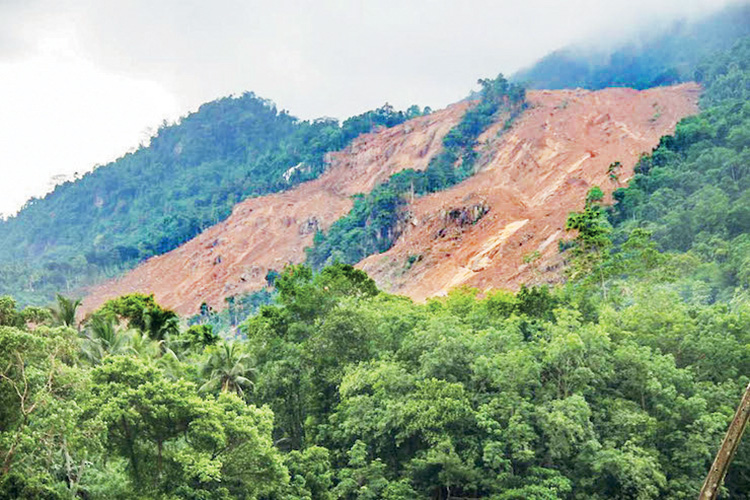
What Sri Lanka’s recent disasters tell us
Sri Lanka has always lived with the moods of the monsoon. For generations, people have grown used to seasonal rhythms of rain, wind and sunshine. Yet what the country has witnessed in recent months feels different. The storms have been stronger, the rainfall more intense, the destruction more widespread and the recovery more painful. The nation has been battered by floods, landslides and hurricane force winds that arrived with little warning and left thousands struggling to rebuild their lives. Scientists say this new pattern is not an accident of nature. It is a direct outcome of the world’s changing climate, which is heating the atmosphere and oceans and turning familiar weather cycles into something far more volatile.
To understand why Sri Lanka is experiencing such severe storms and flooding, it helps to begin with a simple idea. A warmer world holds more energy. When the atmosphere and ocean temperatures rise, they behave like an overheated engine. The monsoon winds strengthen. Rain clouds grow heavier. Sea levels climb. All these changes amplify the forces that produce extreme weather. What used to be occasional, manageable disasters are turning into regular and overwhelming events.
One of the clearest links between climate change and extreme weather is found in rising ocean temperatures. The Indian Ocean is warming faster than most other major bodies of water on the planet. This has serious consequences for Sri Lanka because the surrounding sea regulates the island’s climate. Warm oceans feed moisture into the atmosphere. This moisture then forms clouds that can trigger heavy downpours. When ocean temperatures climb beyond their normal range, the atmosphere becomes supercharged. Rain that once fell steadily over several days can now fall in a matter of hours. This explains why many parts of the country have witnessed sudden cloudbursts that turn roads into rivers and fields into lakes.
Warmer oceans also influence wind patterns. A heated sea surface disturbs air circulation, sometimes producing swirling systems that carry destructive winds and torrential rain. While full scale cyclones are less frequent in Sri Lanka than in parts of India or Bangladesh, the island is increasingly experiencing hybrid storms that bring cyclone like winds without being classified as named cyclones. These storms uproot trees, blow roofs off houses and knock down electricity lines, making post disaster life even harder for affected communities.
Another major factor behind Sri Lanka’s recent extreme weather is the shifting behaviour of the monsoon. For centuries, the island has relied on two monsoons that arrive at predictable times. Farmers, fishermen and traders built their lives around this rhythm. Climate change has disrupted this familiar pattern. The monsoons are becoming erratic. They may arrive later than usual or withdraw too early. In some years they bring too little rain, causing droughts. In other years they arrive with overwhelming intensity, bringing rain far beyond the land’s capacity to absorb. This unpredictability makes it difficult for people to prepare. It also increases the risk of disasters because infrastructure, agriculture and drainage systems were designed for a different climate.
In many regions of Sri Lanka, the land itself has become more vulnerable. Rising temperatures and unpredictable rainfall weaken soil structures. When long dry spells are followed by sudden downpours, the earth cannot hold together. Hillsides become unstable and landslides occur with devastating speed. Villages that once felt safe now face new threats as slopes collapse without warning. These disasters are not simply natural. They are intensified by human activities such as deforestation, poor land management and unplanned construction. Climate change acts as a catalyst, magnifying these risks and turning minor vulnerabilities into life threatening dangers.
The Sea level rise adds yet another layer of concern. The coasts of Sri Lanka are home to millions of people, as well as vital industries such as fishing, tourism and trade. Higher sea levels make coastal flooding far more common, especially when combined with storm surges. During recent storms, waves pushed much farther inland than usual, damaging homes, shops and fishing equipment. Saltwater intrusion also harms soil and freshwater supplies, threatening agriculture in coastal zones. With sea levels continuing to rise, these risks will only grow unless long term protective measures are put in place.
It is also important to recognise the human side of these disasters. Climate change is not only about shifting weather patterns. It is about the people who must confront the consequences. In the aftermath of the recent events, Sri Lankans have shown remarkable courage. Families have worked together to clear debris, rebuild houses, restore livelihoods and comfort those in distress. Yet the burden has not been evenly distributed. Low income households, informal settlements and rural communities often face the greatest hardships. Many of them live in areas more prone to flooding and landslides. They also have fewer resources to recover when disasters strike. Climate change therefore deepens existing inequalities, making vulnerable groups even more exposed.
Children are among the worst affected. Schools often close for days or weeks after floods, interrupting education and adding stress to families already struggling with upheaval. Health risks rise as stagnant water becomes a breeding ground for mosquito borne diseases. Malnutrition can worsen when livelihoods are disrupted and food prices increase. Elderly people face additional risks because they may have difficulty moving quickly during emergencies or accessing medical care after the disaster.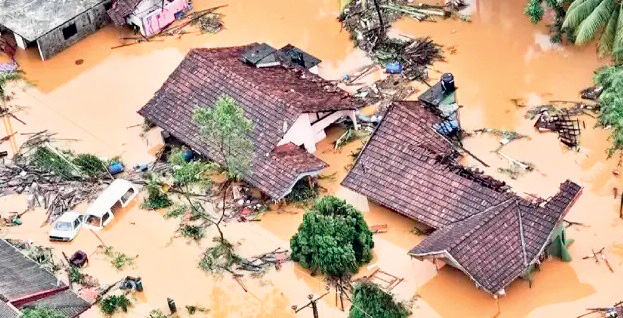
In cities, extreme weather strains essential services. Heavy rains overwhelm drainage systems, causing urban flooding that brings traffic to a halt and damages vehicles and businesses.
Hospitals face sudden influxes of patients. Water treatment plants struggle to maintain supply when rivers overflow or become contaminated. Power outages become common as strong winds damage transmission lines. These disruptions show how deeply interconnected human systems are with the natural environment. When the climate changes, every part of society feels the impact.
Despite the grim realities, there is reason for hope. Sri Lanka has a long history of resilience. Communities have rebuilt after countless storms, droughts and conflicts. Today the country has access to better technology, stronger scientific knowledge and more global support than ever before. What is needed is a clear commitment to prepare for the future rather than react only after disasters strike.
One of the most promising strategies is early warning systems. Accurate forecasts can save lives by giving people the time they need to move to safety. Sri Lanka has already improved its meteorological capabilities, but there is still room to strengthen local communication networks so that warnings reach everyone, including those in remote areas or without internet access. Community education is equally important. When people understand what climate change means for their region, they can make informed choices about housing, farming and water use.
Infrastructure must also evolve. Drainage systems in many towns need upgrading to handle more intense rainfall. Riverbanks require reinforcement to prevent flooding. New buildings, particularly in risk prone zones, must follow safety standards that take climate change into account rather than relying on outdated assumptions about weather patterns. At the same time, restoring natural ecosystems can offer powerful protection. Replanting mangroves, preserving wetlands and maintaining forest cover all help buffer the impact of floods, storms and landslides. Nature is one of the most effective defences against extreme weather when it is allowed to function properly.
On a broader level, Sri Lanka will benefit from global efforts to slow climate change. The island is a small emitter of greenhouse gases compared to many industrialised nations, yet it bears a heavy share of the consequences. International cooperation is essential to reduce harmful emissions, invest in renewable energy and support adaptation in vulnerable countries. Sri Lanka can also strengthen its energy security by expanding solar, wind and other sustainable sources, which reduce dependence on fossil fuels that contribute to climate change.
However, even as governments and scientists work on long term solutions, the experience of ordinary Sri Lankans during the recent storms offers an important lesson. Climate change is not a distant threat. It is happening now. It is felt in flooded living rooms, damaged paddy fields, broken bridges and displaced families. It reshapes the choices parents make for their children and the fears felt by those who live close to rivers or hillsides. It influences food prices, housing stability and health. It is a lived reality, not just an environmental problem.
At its heart, the story of Sri Lanka’s extreme weather is a story about people trying to protect their homes and loved ones. It shows how a global crisis can land with fierce intensity on a small island. But it also reveals the strength of human solidarity. Neighbours rescuing neighbours. Strangers offering food and shelter. Volunteers stepping into danger to help those trapped in rising waters. This spirit of care will be essential in the years ahead as the climate continues to warm and weather events become even more unpredictable.
There is no single solution that will shield Sri Lanka from every future storm. Yet there are many steps the country can take to reduce risk, strengthen communities and build resilience. These efforts will require resources, planning and political will. They will demand cooperation across regions, sectors and generations. Above all, they will require recognising that climate change is not someone else’s problem. It is a shared challenge that demands collective responsibility.
The recent disasters have served as a warning and a call to action. They have shown how quickly weather can turn violent and how deeply it can disrupt daily life. But they have also shown the urgency of preparing for a hotter and more unpredictable world. Sri Lanka has the knowledge and the capability to adapt. Its people have the determination. If these strengths are harnessed with foresight and compassion, the country can chart a safer path through the stormy decades ahead.
Climate change may be reshaping the monsoon, but it does not have to dictate Sri Lanka’s destiny. With the right choices, the island can remain not only a place of natural beauty but also a place of resilience, hope and human connection in the face of a changing planet.
(The writer is an environmentalist.)
by Vincent David ✍️
-
News4 days ago
Lunuwila tragedy not caused by those videoing Bell 212: SLAF
-
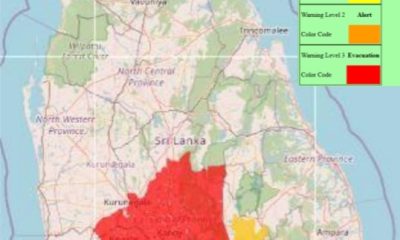
 News3 days ago
News3 days agoLevel III landslide early warning continue to be in force in the districts of Kandy, Kegalle, Kurunegala and Matale
-
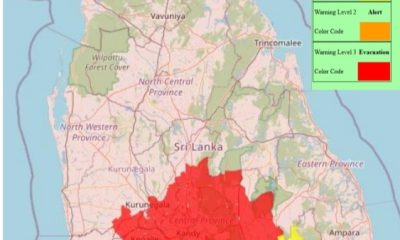
 Latest News5 days ago
Latest News5 days agoLevel III landslide early warnings issued to the districts of Badulla, Kandy, Kegalle, Kurunegala, Matale and Nuwara-Eliya
-
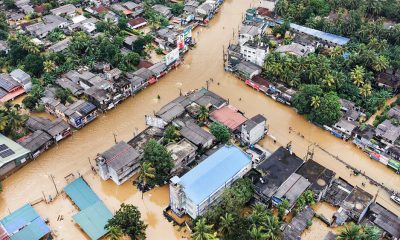
 Features5 days ago
Features5 days agoDitwah: An unusual cyclone
-

 Latest News6 days ago
Latest News6 days agoUpdated Payment Instructions for Disaster Relief Contributions
-

 News1 day ago
News1 day agoCPC delegation meets JVP for talks on disaster response
-

 News1 day ago
News1 day agoA 6th Year Accolade: The Eternal Opulence of My Fair Lady
-

 Latest News6 days ago
Latest News6 days agoLandslide Early Warnings issued to the Districts of Badulla, Colombo, Gampaha, Kalutara, Kandy, Kegalle, Kurunegala, Matale, Moneragala, Nuwara Eliya and Ratnapura




















